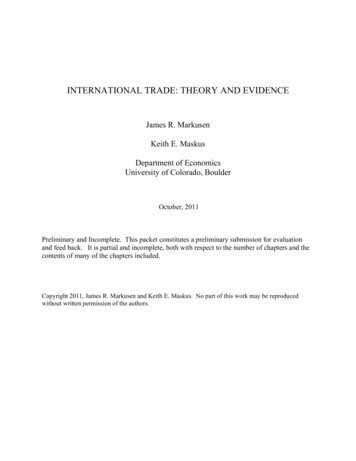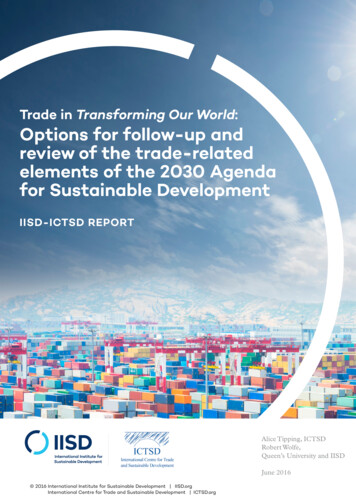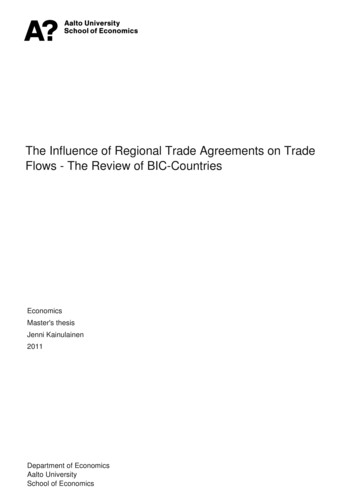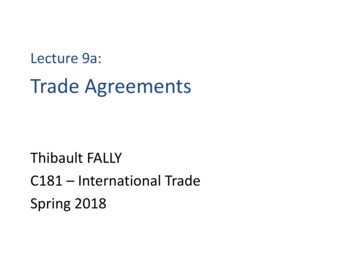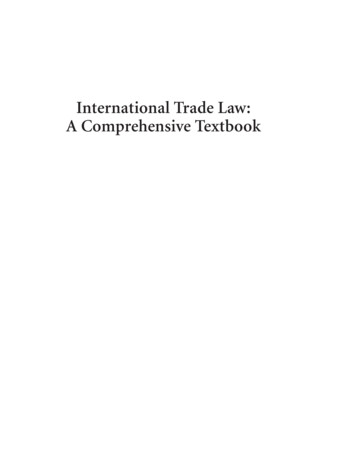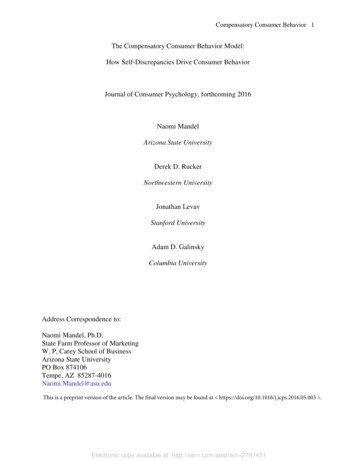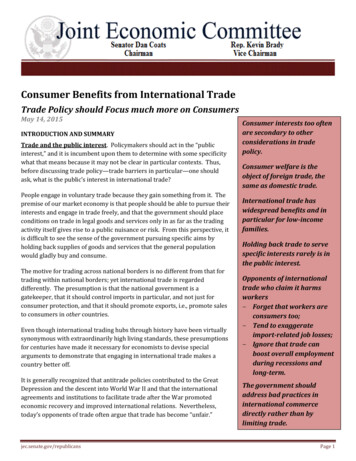
Transcription
REPUBLICAN STAFF ANALYSISConsumer Benefits from International TradeTrade Policy should Focus much more on ConsumersMay 14, 2015INTRODUCTION AND SUMMARYTrade and the public interest. Policymakers should act in the “publicinterest,” and it is incumbent upon them to determine with some specificitywhat that means because it may not be clear in particular contexts. Thus,before discussing trade policy—trade barriers in particular—one shouldask, what is the public’s interest in international trade?People engage in voluntary trade because they gain something from it. Thepremise of our market economy is that people should be able to pursue theirinterests and engage in trade freely, and that the government should placeconditions on trade in legal goods and services only in as far as the tradingactivity itself gives rise to a public nuisance or risk. From this perspective, itis difficult to see the sense of the government pursuing specific aims byholding back supplies of goods and services that the general populationwould gladly buy and consume.The motive for trading across national borders is no different from that fortrading within national borders; yet international trade is regardeddifferently. The presumption is that the national government is agatekeeper, that it should control imports in particular, and not just forconsumer protection, and that it should promote exports, i.e., promote salesto consumers in other countries.Even though international trading hubs through history have been virtuallysynonymous with extraordinarily high living standards, these presumptionsfor centuries have made it necessary for economists to devise specialarguments to demonstrate that engaging in international trade makes acountry better off.It is generally recognized that antitrade policies contributed to the GreatDepression and the descent into World War II and that the internationalagreements and institutions to facilitate trade after the War promotedeconomic recovery and improved international relations. Nevertheless,today’s opponents of trade often argue that trade has become “unfair.”jec.senate.gov/republicansConsumer interests too oftenare secondary to otherconsiderations in tradepolicy.Consumer welfare is theobject of foreign trade, thesame as domestic trade.International trade haswidespread benefits and inparticular for low-incomefamilies.Holding back trade to servespecific interests rarely is inthe public interest.Opponents of internationaltrade who claim it harmsworkers- Forget that workers areconsumers too;- Tend to exaggerateimport-related job losses;- Ignore that trade canboost overall employmentduring recessions andlong-term.The government shouldaddress bad practices ininternational commercedirectly rather than bylimiting trade.Page 1
Joint Economic Committee Republicans Staff AnalysisThe government shouldguard the benefits oftrade to the consumingpublic very carefully.Imports benefitordinary people andespecially lower incomehouseholds.Focus on consumers. The purpose of this commentary is not to explorewhat is or is not fair or harmful about international trade today. Thepurpose is to draw attention to what should be a much fuller public interestdetermination for trade policy. Policies that serve the public interest mustconsider the consumer benefits from trade and assign considerable weightto them. Whatever reasons the government finds for intervening ininternational trade, its benefits to domestic consumers should matter a greatdeal.Consumer benefits should be a prominent part of any trade discussion andweighed against the reservations opponents to trade liberalization raise.From a public interest perspective, the government should keep any policyresponses to particular concerns with imports and their effects as focused aspossible and guard the benefits of trade to the consuming public verycarefully.It is important to recognize that the time has long passed when importsconsisted mostly of luxury items only the rich could afford. The leading U.S.import companies are Wal-Mart, Target, Home Depot, Dole, Lowes, andSears. The everyday goods that “big box” stores in particular bring into thecountry are available at affordable prices that can help consumers withmodest incomes stretch their budgets. Imports benefit ordinary people andespecially lower income households.More study needed of consumer benefits. International trade benefitsconsumers in different ways and through various channels, some of whichtake time. Many economic studies that demonstrate the beneficial nature oftrade use aggregate measures such as GDP to show how economic growthand the national standard of living rise over time with trade liberalization.But they lack the immediacy and concreteness of arguments against trade,or more precisely against imports, that evoke images of closing factories andlaid-off workers.This analysis reviews a number of studies that focus directly on consumerbenefits from imports. The studies take varying approaches and do notnearly capture all the consumer benefits, but they indicate that the gains toconsumers are large. There are not nearly enough such studies. The dearthof studies that directly measure consumer benefits specifically and thefindings of the ones that exist should induce the government to routinely Page 2Sponsor studies of consumer benefits from international trade;Compare consumer benefits of trade liberalization with the domesticadjustment costs;Aim policy intervention narrowly at the adjustment costs rather thanbroadly at holding back trade.jec.senate.gov/republicans
INTERACTION BETWEEN TRADE AND INCOMEJoint Economic Committee Republicans Staff AnalysisAmericans’ average household income is easily 10,000 per year higher as aresult of trade expansion in the past half century. 1 One recent study evenputs the figure as high as 13,600. 2 The United States is the largest importand the second largest export country in the world but in percentage termstrades less than its peers because the volume of internal trade is larger byvirtue of the country’s size. The U.S. import-to-GDP ratio last year, forexample, was 16.5 percent; Germany’s was 40 percent. Three-fourths of the34 OECD member countries have import-to-GDP ratios above 30 percent.The most successful economies in the world trade extensively. Thecountries whose industries are most competitive with U.S. industry andthose with the highest living standards (as identified by OECD’s Better LifeIndex, for instance) are highly engaged in international trade. TheScandinavian countries, Switzerland, the Netherlands, Germany, Japan, HongKong, and Singapore, to name only a few, all have sizable imports andexports relative to their domestic output. Within the euro zone, the leadingcountries have the highest proportions of imports and exports, whereas themembers facing the most severe economic and fiscal challenges, Cyprus,Greece, Italy, Portugal, and Spain, have the lowest ratios of imports andexports to GDP (although still higher than the United States).Figure 1 on page 4 shows imports, exports, and GDP on a per capita basis fornearly all countries in the world. Countries with annual GDP per capitaabove 25,000 have imports of 5,000 per capita or higher. One observationrelevant to the current debate over further trade liberalization is that theproportion of external trade in the United States has much room to growbefore it reaches the levels in many other advanced economies.International trade, especially at an advanced level, is a market drivenphenomenon. The great diversity of traded items is characteristic ofdeveloped, market-based economies in which imports account for asubstantial share of people’s income. A country’s economic system hasmuch to do with the volume and form of its trade. Centrally controlledeconomies tend to trade on simpler terms for a narrower range of items andat lower volume.The causality between international trade and economic growth and livingstandard can run in either direction. Foreign trade can increase income buthigher income can also lead to more trade. Technology and domestic“World Trade and the American Economy,” Presentation to the World Trade WeekKickoff Breakfast, Los Angeles, California by C. Fred Bergsten, Director, PetersonInstitute for International Economics, May 3, 2010; and “The Payoff to America fromGlobal Integration,” by Scott C. Bradford, Paul L. E. Grieco, and Gary Clyde Hufbauer,in C. Fred Bergsten ed. The United States and the World Economy, Institute forInternational Economics, Washington, DC. (2005).2 “How America is Made for Trade,” Matthew J. Slaughter, HSBC Bank USA, N.A.2014. This estimate was cited by House Ways & Means Chairman Paul Ryan andSenator Ted Cruz in their Wall Street Journal editorial “Putting Congress in Chargeon Trade,” April 22, 2015.Americans’ averagehousehold income easily is 10,000 higher per year asa result of trade expansionin the past half century.One recent study even putsthe figure as high as 13,600.The proportion of externaltrade in the United Stateshas much room to growbefore it reaches the levelsin many other advancedeconomies.Centrally controlledeconomies tend totrade on simpler termsfor a narrower rangeof items and at lowervolume.1jec.senate.gov/republicansPage 3
Joint Economic Committee Republicans Staff AnalysisPage 4jec.senate.gov/republicans
Joint Economic Committee Republicans Staff Analysiseconomic policy affect foreign trade volume as well and make it difficult toisolate trade related effects.A study by Frankel and Romer overcomes the problem of causality byrelating a country’s trade to its geographic characteristics that affect the costof conducting foreign trade: size, distance to other countries, sharedborders, and whether it is landlocked. 3 Geographic attributes areindependent of income and government policy, and the difference they makefor trade leads to the conclusion that trade, in fact, raises income. Countriesthat face relatively high trading costs trade less and have lower incomesthan countries that face relatively low trading costs and trade more. Therelation between the geographic component of trade and income in theFrankel and Romer study suggests that a rise of one percentage point in theratio of trade-to-GDP increases income per person by at least one-halfpercent and likely by as much as two percent. 4MEASURING CONSUMER BENEFITS OF TRADEComponents of consumer benefits. International trade benefitsconsumers by lowering prices, improving quality, and widening selection.These benefits are not only the direct result of imported consumer goodsentering domestic markets, but also of the price and product responses bydomestic vendors. In addition, imported commodities and intermediategoods enable domestic producers to lower their cost and enhance retailofferings. Lastly, international trade requires production for export as well,which induces a reallocation of domestic resources relative to autarkytoward specialization in a nation’s comparative advantage. Thus, foreigntrade generates consumer benefits that derive in part directly from importsand in part from responses by the domestic economy. 5Isolating geographicfactors shows thattrade can raisenational income.A one percentage pointincrease in the ratio oftrade-to-GDP raisesincome per person atleast by one-half percentand likely by as much astwo percent.Foreign trade generatesconsumer benefits thatderive in part directlyfrom imports and in partfrom responses by thedomestic economy.Rather than trace the ways in which trade delivers benefits or quantify theircomponent parts, most economic studies of international trade useaggregate measures such as the value of imports plus exports relative tooutput or income at the national level to quantify the gains from trade. Fewstudies focus on consumer benefits specifically.Trade’s contribution to consumer share of national income. A study byLangenfeld and Nieberding 6 applied the Frankel and Romer finding andsimilar ones of other studies to U.S. international trade expansion from 1992to 2002. They calculated the implied increase in domestic consumer benefit“Does Trade Cause Growth?” by Jeffrey A. Frankel and David Romer, AmericanEconomic Review, 89, No. 3 (June 1999), 379-399. The United States is the largestimporter and second largest exporter in the world, but because it is a large country,most trade is internal. Relative to GDP, imports and exports combined are only 30percent. (When calculating GDP, exports are added and imports are subtracted.)4 Ibid, pp. 381, 387, and 394.5 See Appendix I for a fuller discussion.6 “The Benefit of Free Trade to U.S. Consumers—Quantitative Confirmation ofTheoretical Expectation,” by James Langenfeld and James Nieberding, BusinessEconomics, July 2005, 41-51. They estimate consumer surplus associated withimports, not from the price response by domestic suppliers (Table 1, p.42).3jec.senate.gov/republicansPage 5
Joint Economic Committee Republicans Staff Analysisfrom imports per household and found that during this period increasedimports accounted for 15 to 20 percent of the total increase in annual realdisposable income per household, i.e., between 1,583 and 2,080 of 10,387(2002 dollars), depending on whether trade expansion boosts economicgrowth by 1.5 or 2 percent. For the same period, the authors estimated anincrease of 1,229 from five trade agreements based on a United StatesInternational Trade Commission (USITC) study, 7 and they found an increase of 1,613 in annual real disposable income per household using a trade-toincome factor from the 1998 Economic Report of the President. 8A 2005 study estimatedthat the consumerbenefit from U.S. importswas nearly six percent ofmedian householdincome.The study refers to a comparable finding reported by Ambassador RobertZoellick in 2002, the U.S. trade representative at the time, to the SenateFinance Committee. According to Zoellick, the North American Free TradeAgreement (NAFTA) and the Uruguay Round trade agreement generatedadded income and lower taxes (referring to hidden import taxes) of about 1,300 to 2,000 a year (1996 dollars) for the average family of four inAmerica. He believed at the time that new trade negotiations, including theDoha Round, could deliver a further annual income gain of nearly 2,500 tothe average American family of four. 9These estimated benefits reflect only particular advances in tradeliberalization, not total trade. Langenfeld and Nieberding estimated that theconsumer benefit from trade in total was almost six percent of real medianhousehold income or nearly 2,500 per household in 2002 (p. 47). In 2013,real median household income was 52,250, six percent of which would be 3,135. While substantial, the estimates are only of “static” gains; “dynamic”gains are larger because they grow over time in real terms (see Appendix I).Lower prices. There is no more direct way to benefit consumers than withlower prices. The theory of comparative advantage points out thatinternational trade can lower prices if trading partners move theirrespective resources to the areas of their relative strengths in production. Inaddition to cost savings from specialization, competition from abroad alsomay push prices down closer to operating cost. A recent study of 325manufacturing industries from 1997 to 2006 found that a one percentincrease in import market share decreased producer prices by 2.35percent. 10 Both factors—optimization of resource allocation and lowerThe Toyo Round, the Uruguay Round, NAFTA, and Free Trade Agreements withCanada and Israel.8 Janet Yellen was chair of the Council of Economic Advisers at the time.9 Robert B. Zoellick, “Statement before the Committee on Finance of the U.S. Senate,”February 6, 2002, p. 8, and March 9, 2004, p. 41.10 “The effect of low-wage import competition on U.S. inflationary pressure,” byRaphael Auer and Andreas M. Fisher, Journal of Monetary Economics 57 (2010) 491503. Domestic firms also may lower their prices preemptively if their marketsbecome contestable due to trade liberalization so that the import market share doesnot necessarily reflect the full domestic price response.7Page 6jec.senate.gov/republicans
Joint Economic Committee Republicans Staff Analysismark-ups—imply that internationally traded goods will decline in pricerelative to non-traded goods. 11In his book Mad About Trade, 12 Daniel Griswold groups a diverse set of U.S.goods and services by whether their prices had risen more or less than theConsumer Price Index (CPI) 13 from the beginning of 2000 to the end of 2007.With few exceptions, the prices of goods and services most exposed toforeign competition rose less than the CPI and several fell substantially,whereas the prices of those insulated from foreign competition all rose, mostof them substantially.Figure 2 shows the price changes reported by Griswold as well as the pricechanges since then, from 2008 to 2014. The items to the left are tradableexcept for wireless telephone service and eye care and the items to the rightare in the non-trade sector except for bread, fresh fruits, vegetables andprescription drugs. 14Figure 2:There is a remarkabledivergence in pricesbetween goods thatcompete with importsand those that do not.Televisions, toys, dishes and flatware are examples of the former; theirprices declined by between 45 and 93 percent in the last decade and a half.Dry cleaning, haircuts, and motor vehicle repair are among the latter androse in price between 40 and 70 percent during that time. (The numbereditems all are identified in Appendix II.)11 International trade also may reduce inefficiencies that can creep into producers’operations, so-called X-inefficiency, when domestic competition is lacking.12 Made About Trade, Why Main Street America Should Embrace Globalization, DanielT. Griswold, CATO Institute, 2009, Table 2.1, p. 15.13 Consumer price index for all urban consumers (CPI-U), U.S. Department of Labor,Bureau of Labor Statistics.14 Reimport restrictions protect exported patented prescription drugs when theirprices abroad are lower than in the United States. As Griswold points out, drugreimport restrictions are one trade topic where the policy debate recognizesdomestic consumer benefits explicitly (p. 16).jec.senate.gov/republicansThe prices of manyeveryday products tend torise or fall depending onwhether they are in thenon-tradable or tradablesector of the economy.Page 7
Joint Economic Committee Republicans Staff AnalysisThe Bank of International Settlements found a similar price divergence inthe United States, the euro area, and Japan between largely tradable “core”goods (excluding food and energy) and largely non-tradable domesticservices. Since the mid-1990s through 2007, prices for core goodsincreased by declining percentages and even fell for a number of years (blueline), while service prices (green line) continued to rise by percentages thathave remained virtually constant from the late 1990s onward.Figure 3: Trends in Relative Prices of Goods and ServicesOver Four Quarters. Weighted Averages based on 2000 GDP and PPP exchange rates, changes in percent.“Globalization and the Determinants of Domestic Inflation,” William R. White, BIS Working Papers, No.250, Bank for International Settlements, March 2008, Chart 9, left panel, p. 13.International tradeenhances the variety ofproducts available toconsumers.Greater variety. The theory of comparative advantage, particularly thefamiliar two-country, two-product exposition, suggests that while tradeinduced specialization reduces costs, the products remain the same. This isa much too limited inference. Consumers may gain from trade even if thereare no price changes of existing goods. International trade also increases thequality and variety of products that are available to consumers. 15Growth in U. S. import product variety has been an important source ofconsumer gains from trade. As reported in a study by Broda and Weinstein,the share of imported goods in U.S. GDP more than doubled from 4.8 percentto 11.7 percent and import varieties rose from 71,420 to 259,215 between1972 and 2001. 16 The authors arrive at a measure of the consumer welfaregain from increased variety by applying the type of adjustment made to costof-living indices, such as the CPI, that aim to reflect changing consumerA formal explanation of international trade based on increased product varietyand economies of scale earned Paul Krugman the 2008 Nobel Prize in Economics.His work is part of what is known as “New Trade Theory,” which explains the largevolume of trade among advanced countries with similar resource endowments andtechnologies. See, for example, “Increasing Returns, Monopolistic Competition, andInternational Trade,” Journal of International Economics 9 (1979), 469-479 and“Scale Economies, Product Differentiation, and the Pattern of Trade,” The AmericanEconomic Review, Vol. 70, No. 5 (Dec., 1980), 950-959, both by Paul R. Krugman.16 The study defines a variety as a particular good, such as red wine, produced in aparticular country, such as France. “Globalization and the Gains from Variety,”Christian Broda and David E. Weinstein, The Quarterly Journal of Economics, May2006, p. 550.15Page 8jec.senate.gov/republicans
Joint Economic Committee Republicans Staff Analysispreferences (i.e., the changing composition of a representative basket ofpurchases), product quality improvements, and new kinds of goods. To theextent that a price index does not capture these changes, it overstates thecost of living. 17 Relative to the variety-adjusted import price index thatBroda and Weinstein constructed, the conventional import price index hadan upward bias of 28 percent over the period.For the lower, variety-adjusted import prices, the authors estimated the“compensating variation,” meaning the income consumers would be willingto give up in order to keep the full incremental variety of imports. Brodaand Weinstein estimated that for access to the net new varieties added eachyear, consumers would have paid up to 0.1 percent of their income and in2001 would have paid 2.6 percent of their income to keep the selection fromfalling back to the level available in 1972. 18A paper by Mohler and Seitz using the same methodology on 27 EuropeanUnion (EU) member countries for the period 1999 to 2008, found positiveconsumer welfare gains in all but five countries (two of which were notsignificantly different from zero). 19 Notably, the gains were largest amongnew member countries and smaller among long-time members, particularlythe four largest economies, France, Germany, Great Britain, and Italy. Theeconomies of these major, long-time EU members had well-established tradelinks within the EU as well as globally prior to the period of study whereasthe new members experienced substantial trade liberalization, especiallywithin the EU. Mohler and Seitz separated EU from non-EU trade and foundthat the former made a much bigger difference for the new members thanthe latter, presumably because EU membership facilitates trade mostly withother members. They also found that new members are able to catch up tothe incumbent members in terms of the trade benefits they realize.Studies of the UnitedStates and the EUshow that consumersplace significant valueon product variety.The Mohler and Seitz findings highlight that the kind of welfare gain fromtrade liberalization they consider, increased variety, is lasting but static; agiven reduction in trade barriers generates a constant gain in welfare.Who are the consumers receiving these benefits? The consumer surplusfrom import variety is for the nation as a whole. It can be expressed as apercentage of national income or output (GDP). Since aggregate measuresare used to compute it, one cannot draw inferences about which consumersbenefit. But the days are gone when imports were predominantly luxurygoods only the rich could afford, such as gems, ivory, and silk. Not only canmany more people afford these kinds of goods today, imports largely aremass-produced consumer products. The first column in Table 1 shows17 See, for example, “Price measurement in the United States: a decade after theBostic Report,” Monthly Labor Review, May 2006.18 Broda and Weinstein, p. 543. These are percentages of national income or GDP;they represent the so-called consumer surplus from import variety.19 “The Gains from Variety in the European Union,” Lukas Mohler and Michael Seitz,Munich Discussion Paper No. 2010-24, Department of Economics, University ofMunich, March 2010.jec.senate.gov/republicansPage 9
Joint Economic Committee Republicans Staff Analysismany items in the shopping carts of average Americans, so the trade benefitsdo reach the general population.Big box retailers areamong the largestimport companies andconfer substantialbenefits on a widesegment of consumers,especially lower incomefamilies.One can go a step further and say that foreign trade disproportionatelybenefits modest to low-income people. The top five U.S. import companies areWalmart, Target, Home Depot, Dole, Lowes, and Sears. 20 A study by Hausmanand Leibtag of super stores, mass merchandizers and club stores, so-called bigbox stores, shows they confer substantial benefits on consumers that areproportionately larger the lower the income. Households with less than 10,000 in annual income benefit 50 percent more than the average benefitrealized. In total, the existence of big box stores makes consumers better offby the equivalent of 25 percent on average of annual food spending. 21 Whilethe authors only studied food items, these stores sell a wide range of products,many of them imported and/or affected by import competition. Another studyby Basker uses 10 nonfood products and finds considerable downward pricemovement for Wal-Mart. 22Jason Furman, the current chairman of the Council of Economic Advisers, in a2005 paper computed the welfare gain from the Hausman-Leitag study indollar savings as 782 per household in 2003. Taking into account that lowerincome families spend a larger share of their income on food, he showed thatthey benefit proportionately more than higher income families, namely by awelfare increase of 6.5 percent of income in the lowest quintile comparedwith an average of 1.5 percent (see Table 2). 23Table 1: Benefits for Food Consumers per HouseholdPretax Income Welfare Increase Welfare Increase asQuintilePercent of IncomeBottomSecondThirdFourthFifthAll 530 678 779 932 1,126 7826.5%3.2%2.1%1.5%0.9%1.5%Reproduced in abbreviated form from Table 1 entitled “Benefits for Food Consumers,” in “Wal-Mart: AProgressive Success Story.” Data from Bureau of Labor Statistics, June 2005, Consumer Expenditures in2003 and Jason Furman’s calculations.Chiquita ranks seventh, LG eighth, Heineken ninth, and Phillips Electronics tenth,Journal of Commerce, May 29, 2014, rs.21 “Consumer Benefits from Increased Competition in Shopping Outlets: Measuringthe Effect of Wal-Mart,” Jerry Hausman and Ephraim Leibtag, Working Paper 11809,National Bureau of Economic Research, December 2005, pp. 24, 25. Subsequentlypublished in Journal of Applied Econometrics: 1157-1177 (2007). Hausman andLeibtag do not sum up the benefits for the country as a whole.22 Aspirin, cigarettes, Coke, detergent, Kleenex, shampoo, tooth paste, shirts, pants,and underwear; “Selling a Cheaper Mousetrap: Wal-Mart’s Effect on Retail Prices,”Emek Basker, University of Missouri, March 2005 CSelling%20a%20Cheaper%20Mousetrap.pdf.)23 “Wal-Mart: A Progressive Success Story,” Jason Furman, November 28, t.pdf.)20Page 10jec.senate.gov/republicans
Joint Economic Committee Republicans Staff AnalysisHe reported that the savings from all goods at Wal-Mart alone areenormous—a total of 263 billion in 2004, or 2,329 per household. 24In testimony before the Senate Finance Committee in 2004 cited earlier,Ambassador Zoellick made the following observation:Arguing for trade barriers is like arguing for a tax on single workingmoms, because that’s who pays the most in import taxes as a percentageof household income. Our goal is to cut those hidden import taxes—whileother countries cut theirs too—to give working families a boost (p. 41).TRADE LIBERALIZATION AND EMPLOYMENTIt is not the purpose of this commentary to analyze the various objections totrade liberalization or those based specifically on employment or wageeffects, but it is important to point out that the objections for the most partare narrowly focused.Workers are consumers too. The ultimate purpose of foreign trade is togain access to goods and services that otherwise would not be available oraffordable, and workers are also consumers. Furman observed that eight inten Americans shop at Wal-Mart, and the Hausman-Leibtag study found thatWhile we do not estimate the costs to workers who may receivelower wages and benefits, we find the effects of supercenter entryand expansion to be sufficiently large so that overall we find it to beextremely unlikely that the expansion of supercenters does notconfer a significant overall benefit to consumers (p. 2).A fundamental governing principle of domestic economic policy is topreserve the freedom of citizens to pursue their own interests. Tradebarriers interfere with people’s ability to purchase goods and services,which presumptively is in their interest as long as trade is voluntary andshould be their right as long as the objects of trade are legal. Barring orrestricting economic activity, be it within or across national borders,constrains that freedom for everyone within and outside the labor force. 25While there may be costs to some from trade liberalization, there are costsand risks to all activities, which do not justify stopping the activities. Inresponse to traffic fatalities, for example, the gover
May 14, 2015 · trade use aggregate measures such as GDP to show how economic growth and the national standard of living rise over time with trade liberalization. But they lack the immediacy and concreteness of arguments against trade, or more precisely against imports, that

